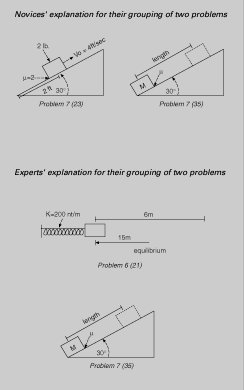How People Learn:
Brain, Mind,
Experience, and School
|
|
|
| |
FIGURE 2.4
|

|
|
Explanations
Novice 1: These deal with blocks on an incline plane.
Novice 5: Incline plane problems, coefficient of friction.
Novice 6: Blocks on inclined planes with angles.
|
| |
Explanations
Expert 2: Conservation of energy.
Expert 3: Work-theory theorem. They are all straight-forward problems.
Expert 4: These can be done from energy considerations. Either you
should know the principle of conservation of energy, or work is lost
somewhere.
|
An example of sortings of physics problems made by
novices and experts. Each picture above represents a diagram that can
be drawn from the storyline of a physics problem taken from an
introductory physics textbook. The novices and experts in this study
were asked to categorize many such problems based on similarity of
solution. The two pairs show a marked contrast in the experts' and
novices' categorization schemes. Novices tend to categorize physics
problems as being solved similarly if they "look the same" (that is,
share the same surface features), whereas experts categorize according
to the major principle that could be applied to solve the problems.
SOURCE: Adapted from Chi et al.(1981).
|
|
|
|
|